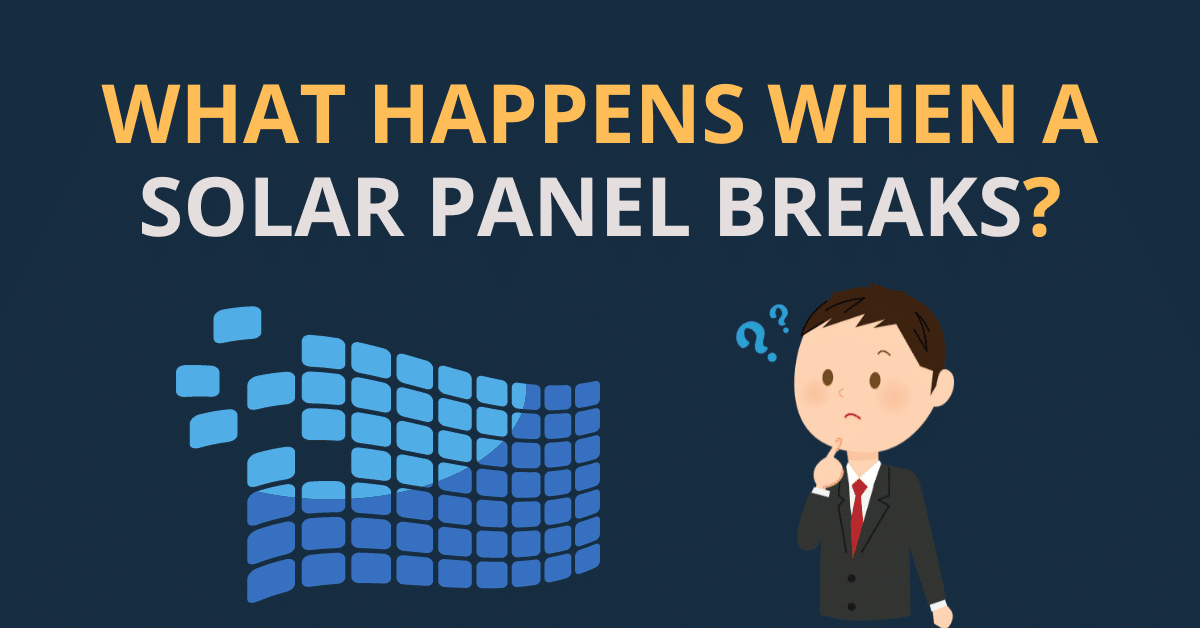Imagine basking in the glow of sunshine, not just as warmth, but as free electricity powering your home. Solar panels offer a clean, renewable energy source, but like any equipment, they’re not invincible. So, what happens when a solar panel breaks? Don’t worry, we’ll shed some light on the situation and guide you towards solutions.
Broken Sunshine: Types of Damage and Their Impact
What Happens When a Solar Panel Breaks?
The consequences of damage to a solar panel are directly related to the degree of damage, and in the case of minor damage, such as bad spots and small pits, the panel can still be used and generate electricity normally as long as its circuitry is not affected.
Solar panels can break in two ways: direct impact or degradation. which are the extent of damages.
Direct impact occurs when something hits the panel with enough force to crack or shatter it. This could be caused by hail, debris, vandalism, or accidents.
Degradation occurs when the panel deteriorates over time due to exposure to weather or other factors.
This could be caused by water damage, corrosion, delamination, or microcracks. These causes can affect the performance and lifespan of solar panels by reducing their ability to absorb and generate electricity.
Solar panels can break in two main ways: direct impact and degradation.
Direct impact: Think of hailstorms, falling branches, or even an errant frisbee. These forceful encounters can crack or shatter the panel’s glass, disrupting its ability to capture sunlight and generate electricity.
Degradation: Over time, exposure to weather and environmental factors like heat, moisture, and UV rays can take their toll. This gradual wear and tear can lead to micro-cracks, discoloration, and even delamination, where the layers of the panel separate.
The Shadow of Trouble: Consequences of a Broken Panel
A broken panel isn’t just an eyesore; it can have real consequences for your solar energy system and your wallet:
Reduced power output: A damaged panel becomes less efficient at converting sunlight into electricity. This means you’ll get less power from your system, potentially leading to higher reliance on the grid and increased electricity bills.
Safety hazards: Exposed wires, broken glass, and electrical malfunctions can pose a serious risk of shock, fire, or cuts. Don’t gamble with safety; address any damage promptly.
Higher maintenance costs: Regular inspections and repairs become necessary to keep your system functioning properly. In severe cases, you might need to replace the entire panel, adding to the financial burden.
Rays of Hope: Preventing and Fixing Broken Panels
The good news is that you can take steps to protect your solar investment and minimize the risk of damage:
Choose wisely: Invest in high-quality, durable panels that can withstand the elements. Look for certifications like IEC and UL for added assurance.
Installation matters: Ensure proper installation by qualified professionals who follow manufacturer recommendations and local building codes.
Keep an eye out: Regularly inspect your panels for any signs of cracks, discoloration, or loose connections. Early detection can prevent bigger problems.
Clean with care: Use soft brushes and gentle cleaning solutions to avoid scratching or damaging the panel’s surface.
When the Sun Sets on a Panel: Repair or Replace?
The decision to repair or replace a broken panel depends on several factors:
Extent of damage: Minor cracks or chips might be repairable, while severe fractures or extensive delamination often call for replacement.
Panel age and warranty: Older panels nearing the end of their lifespan might not be worth the repair cost. Check your warranty coverage for potential replacements.
Cost-effectiveness: Compare the repair cost with the price of a new panel and factor in future maintenance needs.
Remember, consulting with a qualified solar professional is crucial for making the best decision for your specific situation.
Bonus tip: Consider joining a local solar community group to connect with other solar users, share experiences, and learn valuable tips for maintaining your system.
FAQ:
Q: How can I tell if my solar panel is broken?
• A: You can tell if your solar panel is broken by looking for visible signs of damage, such as cracks, chips, holes, or discoloration.
You can also use a multimeter to measure the voltage and current of your panel and compare it with the expected values. If the values are lower than normal, it means that your panel is not working properly.
Q: How often should I inspect and clean my solar panels?
A: You should inspect and clean your solar panels at least once a year, or more often if you live in an area with high dust, pollen, or snow.
You should also check your panels after any severe weather events, such as storms, hail, or strong winds.
Q: How much does it cost to repair or replace a broken solar panel?
A: The cost to repair or replace a broken solar panel depends on several factors, such as the type and size of the panel, the extent and location of the damage, and the availability and quality of the service.
Generally, repairing a panel is cheaper than replacing it, but it may not be worth it if the damage is too severe or the panel is too old.
The average cost of repairing a panel ranges from $100 to $300, while the average cost of replacing a panel ranges from $400 to $600.
